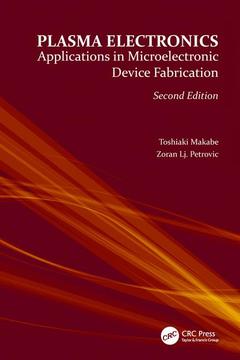Plasma Electronics (2nd Ed.) Applications in Microelectronic Device Fabrication
Auteurs : Makabe Toshiaki, Petrovic Zoran Lj.

Beyond enabling new capabilities, plasma-based techniques, characterized by quantum radicals of feed gases, hold the potential to enhance and improve many processes and applications. Following in the tradition of its popular predecessor, Plasma Electronics, Second Edition: Applications in Microelectronic Device Fabrication explains the fundamental physics and numerical methods required to bring these technologies from the laboratory to the factory.
Emphasizing computational algorithms and techniques, this updated edition of a popular monograph supplies a complete and up-to-date picture of plasma physics, computational methods, applications, and processing techniques. Reflecting the growing importance of computer-aided approaches to plasma analysis and synthesis, it showcases recent advances in fabrication from micro- and nano-electronics, MEMS/NEMS, and the biological sciences.
A helpful resource for anyone learning about collisional plasma structure, function, and applications, this edition reflects the latest progress in the quantitative understanding of non-equilibrium low-temperature plasma, surface processing, and predictive modeling of the plasma and the process. Filled with new figures, tables, problems, and exercises, it includes a new chapter on the development of atmospheric-pressure plasma, in particular microcell plasma, with a discussion of its practical application to improve surface efficiency.
The book provides an up-to-date discussion of MEMS fabrication and phase transition between capacitive and inductive modes in an inductively coupled plasma. In addition to new sections on the phase transition between the capacitive and inductive modes in an ICP and MOS-transistor and MEMS fabrications, the book presents a new discussion of heat transfer and heating of the media and the reactor.
Integrating physics, numerical methods, and practical applications, this bookequips you with the up-to-date understanding required to scale up lab breakthroughs into industrial innovations.
Introduction. Phenomenological Description of the Charged Particle Transport. Macroscopic Plasma Characteristics. Elementary Processes in Gas Phase and on Surfaces. The Boltzmann Equation and Transport Equations of Charged Particles. General Properties of Charged Particle Transport in Gases. Modeling of Nonequilibrium(Low Temperature) Plasmas. Numerical Procedure of Modeling. Capacitively Coupled Plasma. Inductively Coupled Plasma.
Magnetically Enhanced Plasma. Plasma Processing and Related Topics. Atmospheric Pressure, Low Temperature Plasma.
Toshiaki Makabe received his BSc, MSc, and Ph.D. degrees in electrical engineering all from Keio University. He became a Professor of Electronics and Electrical Engineering in the Faculty of Science and Technology at Keio University in 1991. He also served as a guest professor at POSTECH, Ruhr University Bochum, and Xi’an Jiaotong University. He was Dean of the Faculty of Science and Technology and Chair of the Graduate School from 2007 to 2009. Since 2009, he has been the Vice-President of Keio University in charge of research. He has published more than 170 papers in peer-reviewed international journals, and has given invited talks at more than 80 international conferences in the field of non-equilibrium, low-temperature plasmas and related basic transport theory, and surface processes. He is on the editorial board of Plasma Sources Science and Technology, and many times he has been a guest editor of the special issue about the low temperature plasma and the surface process of the Japanese Journal of Applied Physics, Australian Journal of Physics, Journal of Vacuum Science and Technology A, IEEE Transactions on Plasma Science, and Applied Surface Science, etc. He received the awards; "Fluid Science Prize" in 2003 from the Institute of Fluid Science, Tohoku University, "Plasma Electronics Prize" in 2004 from the Japan Society of Applied Physics, "Plasma Prize" in 2006 from the American Vacuum Society, etc. He is an associate member of the Science Council of Japan, and a foreign member of the Serbian Academy of Sciences and Arts. He is a fellow of the Institute of Physics, the American Vacuum Society, the Japan Society of Applied Physics, and the Japan Federation of Engineering Societies.
Zoran Lj. Petrovic obtained his Master’s degree in the Department of Applied Physics, Faculty of Electrical Engineering in the University of Belgrade, and earned his Ph.D from Austra
Date de parution : 10-2016
15.6x23.4 cm
Date de parution : 02-2015
15.6x23.4 cm
Thèmes de Plasma Electronics :
Mots-clés :
Low Temperature Plasma; Feed Gas Molecules; number; Ionization Rate; density; Bulk Plasma; low; Electron Temperature Te; temperature; Feed Gas; drift; Magnetron Plasma; velocity; Collisionless Plasma; feed; Swarm Parameter; gas; Rf Plasma; molecules; High Density Plasma; bulk; Stepwise Ionization; Differential Cross Section; Charged Particles; ICP; Longrange Coulomb Interaction; Boltzmann Equation; Electron Swarm; Velocity Space; Elastic Collisions; Equivalent Circuit; Powered Electrode; Maximum Power Transfer Theorem; Drift Diffusion Equation; Ionization Cross Section



